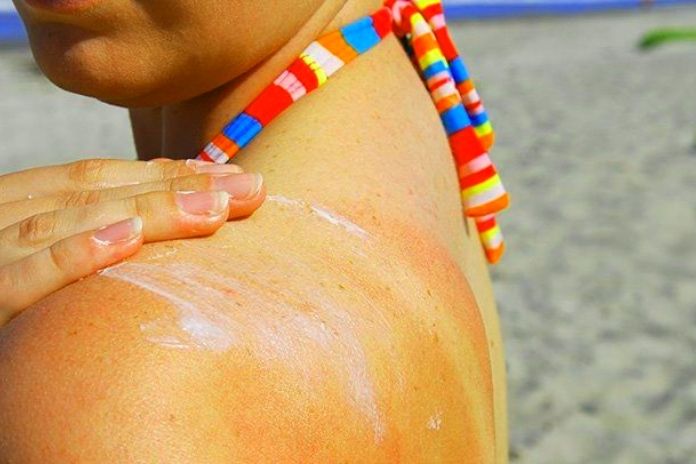If the skin cannot protect itself adequately from UV rays, it reacts with blisters, itching and reddening. We tell you how to protect yourself from sun allergy and what you can do in an emergency.
Summer is back, but not everyone is happy about hours of sunshine and hot temperatures: for those who react to UV rays with a sun allergy, the holiday is quickly over.
We tell you how to protect yourself and what to do in an emergency.
What Is A Sun Allergy?
What many people experience in the sun is not a sun allergy but is called ‘polymorphic light eruption’ in technical jargon.
If a sun allergy occurs, the body’s natural protective mechanism against UV rays fails, which is why one also speaks of hypersensitivity to sun rays.
Means: Itchy wheals form on untanned skin when exposed to the sun, especially in sensitive areas such as the neck and décolleté.
In the neck because it is exposed to the sun as a so-called terrace, in the neckline because the skin is fragile there.
Less common, but almost more unpleasant, is ‘Mallorca acne’, a skin reaction to sunscreen.
When UV rays hit the skin, free radicals form, wreaking havoc if they are not caught.
With a corresponding tendency, small pimples similar to acne form.
Triggers are usually the fat content in the sunscreen, sometimes emulsifiers. Therefore, those prone to Mallorca acne should use sun gels that do not contain emulsifiers and lipids.
Symptoms: This Is How A Sun Allergy Manifests Itself
While the body usually reacts to UV rays by producing melanin, which gives our skin its brown color and protects the skin cells, it can no longer offer the skin sufficient protection in the case of a sun allergy.
Sun allergies most commonly occur when the skin has not been exposed to the sun for a long time.
The consequences are blisters or nodules, itching and reddened skin, which can even swell.
Since the symptoms often do not appear as a direct result of sunbathing, it is sometimes not easy to identify UV radiation as the cause.
Home Remedies For Sun Allergy
Anyone who suffers from the symptoms does not have to resort to chemicals straight away.
Numerous home remedies can alleviate the symptoms. These include, for example, lavender oil, which can relieve itching, or marigold ointment, which accelerates the regeneration of irritated skin.
But the gel from the Aloe Vera plant also soothes stressed skin and has a disinfecting and anti-inflammatory effect.
A curd compress can have a cooling effect and relieve itching. To do this, spread the quark generously on a kitchen towel and place it folded on the affected areas.
Cucumbers restore moisture to the skin. To do this, puree a cucumber and apply the mash to the irritated areas.
When Should You See A Doctor?
In principle, you can get a sun allergy under control yourself or ensure that it does not develop in the first place.
However, if you are unsure about the symptoms or are severely restricted – for example, feeling tormenting itching or extremely burning skin – you can have your doctor prescribe anti-inflammatory medication, usually containing cortisone.
The best way to diagnose is to see a doctor as soon as symptoms appear, as skin signs can subside within a few hours or days, making diagnosis difficult.
A visit to the doctor can also rule out other diseases with similar symptoms.
Treatment
While there is no immediate cure for sun allergy, symptoms can be quickly alleviated to relieve the sufferer.
Cooling Units: The symptoms can be alleviated with the help of cooling units (caution: do not put them directly on the skin!) or moist envelopes.
Ointments: If the pain is severe or the itching unbearable, antihistamines applied to the affected areas in the form of creams can help.
Anti-inflammatory drugs with cortisone: They reduce itching and burning.
This Is How You Protect Yourself From Sun Allergies
Anyone who knows that their skin reacts sensitively to the sun’s rays can take preventive measures to prevent the development of a sun allergy or at least alleviate the symptoms:
- Give your skin time to get used to the sun’s rays, especially after a long winter.
- Avoid the midday sun between 11 a.m. and 3 p.m. because this is when UV radiation is most intense.
- Wear clothing with a special coating that absorbs UV rays.
- Always use sunscreen, even if you are only outside for a short time.
- Protection from SPF 30 is recommended. Since the skin should not be irritated, you should use sunscreen utterly free of fragrances and preservatives.
- A so-called light hardening at the dermatologist carried out several weeks before a holiday can help those affected.
- The skin is exposed to medical UV rays for a short time every day for several weeks. Many sufferers can tolerate the sun better after this treatment. But be a careful fallacy: Regularly going to the solarium does not help harden!
ALSO READ: THIS HELPS WITH SUNSTROKE AND HEAT STROKE

